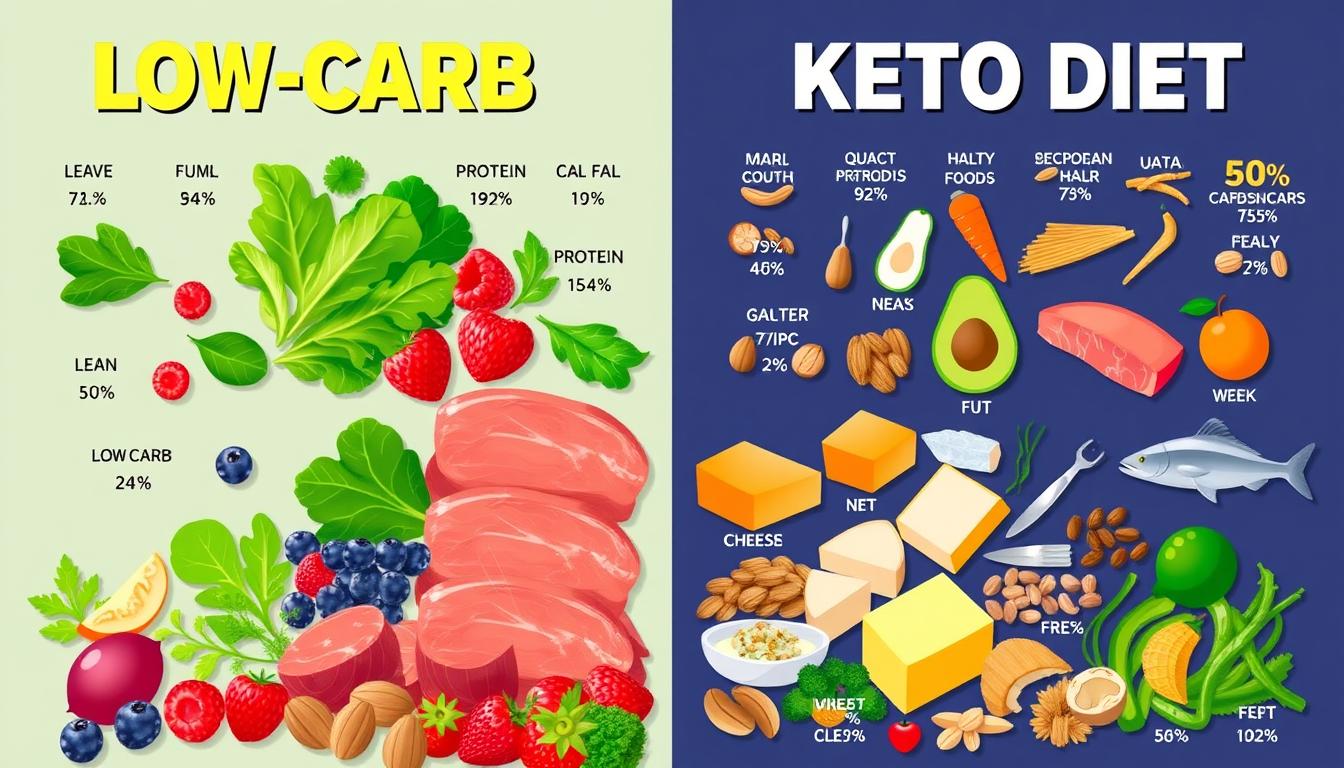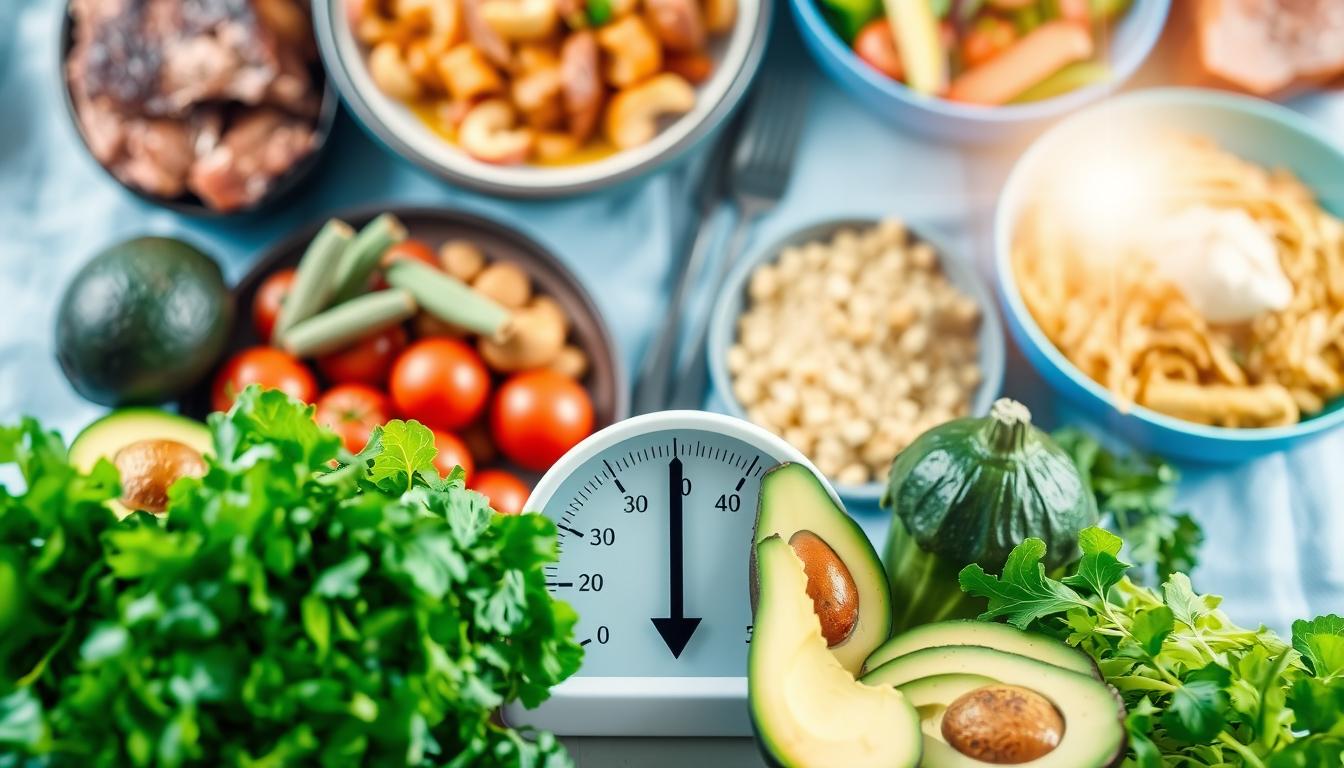When it comes to losing weight and eating healthy, two diets are often talked about: low-carb diets and the keto diet. Each has its own rules and benefits. But what makes them different? We’ll explore the low-carb and keto diets, their differences, and help you choose the best for your health and fitness goals.
If you want to lose weight or live a healthier life, knowing about these diets is key. We’ll cover everything from diet plans to healthy eating habits. This will help you make a smart choice about what to eat.
Understanding Low-Carb Diet vs. Keto: Basic Principles
Many people are choosing low-carb diets for better health. Two diets, low-carb and keto, are popular. They differ in how they approach nutrition and ketosis.
A low-carb diet cuts down on carbs like sugars and starches. It helps with weight loss and health. The keto diet, or ketogenic diet, aims to make the body burn fat for energy instead of carbs.
What Defines a Low-Carb Diet
A low-carb diet limits carbs from foods like bread and pasta. It focuses on protein and healthy fats. This diet can help with weight loss and blood sugar control.
What Defines a Ketogenic Diet
The ketogenic diet is more specific. It drastically cuts carbs and increases healthy fats. Foods like avocados and nuts are encouraged.
Core Differences in Approach
The main difference is in their approach to nutrition and ketosis. Low-carb diets are more flexible, allowing a variety of foods. Ketogenic diets are stricter, needing a precise balance of macronutrients for ketosis.
| Diet | Carbohydrate Intake | Protein Intake | Fat Intake |
|---|---|---|---|
| Low-Carb Diet | Restricted | Moderate | High |
| Ketogenic Diet | Very Low | Moderate | Very High |
Understanding these diets helps people choose the right one for their health goals.
The Science Behind Carb Restriction
Living a healthy lifestyle means knowing how carbs affect us. Cutting down on carbs can change our metabolism, blood sugar, and wellness. It can lead to weight loss, better blood sugar control, and more energy, all helping with fitness.
Carb restriction changes how our body uses energy. With less carbs, we burn more fat, leading to weight loss and better wellness. It also helps control blood sugar and boosts energy, great for those wanting to get fit.
- Weight loss: Reducing carbs can lead to significant weight loss, especially at first.
- Improved blood sugar control: Carb restriction helps keep blood sugar stable, lowering the risk of type 2 diabetes.
- Increased energy: Many find more energy on a low-carb diet, making exercise and a healthy lifestyle easier.
In summary, carb restriction’s science is complex, but its benefits are clear. Understanding its effects helps us make better diet choices, leading to better wellness and fitness.
| Benefit | Description |
|---|---|
| Weight Loss | Reducing carbohydrate intake can lead to significant weight loss. |
| Improved Blood Sugar Control | Carb restriction can help regulate blood sugar levels, reducing the risk of developing conditions such as type 2 diabetes. |
| Increased Energy | Many people who adopt a low-carb diet report increased energy levels, making it easier to engage in physical activity and maintain a healthy lifestyle. |
Macronutrient Breakdown: How They Differ
Understanding the macronutrient breakdown is key to success in diet plans. Low-carb diets and the keto diet have different ratios of carbs, protein, and fat. These nutrients give us energy and help our bodies grow and repair.
A good diet plan meets your specific needs and goals. It considers your activity level, weight, and health. Low-carb diets focus on more protein and fat, with less carbs. The keto diet has very low carbs, moderate protein, and lots of fat.
Here’s a quick look at the macronutrient ratios for each diet:
- Low-carb diet: 50-150g of carbohydrates, 100-200g of protein, and 70-100g of fat
- Keto diet: 20-50g of carbohydrates, 75-100g of protein, and 150-200g of fat

Remember, nutrition and diet plans are very personal. What works for one person might not work for another. Knowing the macronutrient breakdown helps you choose the right diet plan for your needs and goals.
| Diet | Carbohydrates | Protein | Fat |
|---|---|---|---|
| Low-carb | 50-150g | 100-200g | 70-100g |
| Keto | 20-50g | 75-100g | 150-200g |
Health Benefits and Potential Risks
Both low-carb diets and the keto diet can help with weight loss. They focus on healthy eating to improve wellness and lower disease risk. Benefits include better blood sugar control, more energy, and clearer thinking.
A good diet plan can help reach weight loss goals and boost wellness. It’s important to know the risks, like nutrient gaps and social issues. By choosing wisely and eating well, you can avoid these problems and enjoy the diet’s benefits.

- Improved blood sugar control
- Increased energy levels
- Enhanced mental clarity
- Nutrient deficiencies
- Social challenges
- Long-term sustainability concerns
Knowing the benefits and risks helps make smart diet choices. Always talk to a doctor before starting a new diet, especially if you have health issues. With the right healthy eating and wellness approach, you can lose weight and feel better overall.
| Diet | Benefits | Risks |
|---|---|---|
| Low-Carb | Weight loss, improved blood sugar control | Nutrient deficiencies, social challenges |
| Keto | Increased energy levels, enhanced mental clarity | Long-term sustainability concerns, potential negative impact on certain health conditions |
Food Lists and Meal Planning
Adopting a healthy lifestyle starts with good nutrition. Meal planning is key for a balanced diet, whether you’re on a low-carb or keto diet. Knowing which foods are allowed and restricted is crucial for making smart nutrition choices.
Starting a healthy lifestyle means focusing on whole foods. This ensures you get all the nutrients you need. For a low-carb diet, eat lean meats, fish, and poultry. Also, include low-carb veggies like leafy greens and broccoli.
Acceptable Foods on Low-Carb
- Lean meats, such as chicken and turkey
- Fish and seafood, like salmon and shrimp
- Low-carb vegetables, including leafy greens and broccoli
- Healthy fats, like avocado and olive oil
Keto diets focus on high-fat, low-carb foods. This includes fatty meats, full-fat dairy, and healthy oils. Adding these to your meals helps you stay healthy and reach your nutrition goals.

Keto-Approved Foods
- Fatty meats, such as beef and pork
- Full-fat dairy products, like cheese and butter
- Healthy oils, including coconut oil and olive oil
Understanding meal planning and nutrition is key to a healthy lifestyle. Whether on a low-carb or keto diet, good nutrition is vital for health and wellness.
Exercise and Performance Impact
Both low-carb and keto diets have their ups and downs when it comes to fitness and exercise. It’s key to know how they affect athletic performance for those who work out a lot.
A low-carb diet works well for high-intensity workouts like HIIT. But, it might not give enough energy for long runs or bike rides. A keto diet, however, is great for long activities because it helps the body use fat for energy.
Working Out on Low-Carb
Exercising on a low-carb diet needs some planning to keep energy up. Here are some tips:
- Eat a balanced meal with protein and healthy fats before exercise
- Choose low-carb snacks that are rich in electrolytes
- Stay hydrated by drinking plenty of water
Athletic Performance on Keto
People on a keto diet might see better athletic performance because they burn more fat. But, a keto diet might not be the best for quick, intense workouts.
In short, both low-carb and keto diets can greatly affect fitness and athletic performance. Knowing the good and bad of each diet helps people choose the right one for their workouts and diet.
| Diet | Benefits | Challenges |
|---|---|---|
| Low-Carb | Improved blood sugar control, increased fat burning | May not provide enough energy for endurance activities |
| Keto | Improved athletic performance, increased fat burning | May not be suitable for high-intensity activities |
Sustainability and Lifestyle Factors
Adopting a low-carb or keto diet requires thinking about how sustainable it is for your lifestyle. A healthy lifestyle goes beyond just what you eat. It’s about your overall wellness and keeping up with your diet over time.
Having a support system, like friends and family, is key to success. Meal planning is also crucial. It helps you stay on track and get the nutrients you need. Here are some tips for sustainable meal planning:
- Plan your meals ahead of time
- Buy healthy ingredients
- Make meals in bulk
By following these tips, you can keep a healthy lifestyle and reach your wellness goals. It’s about finding a balance that fits your life and being mindful of sustainability.
The secret to success is finding a diet you can stick to long-term. It should match your values and lifestyle. By considering the sustainability and lifestyle aspects of a low-carb or keto diet, you can make a choice that’s right for you.
| Diet | Sustainability | Lifestyle Factors |
|---|---|---|
| Low-Carb Diet | Medium | Requires careful meal planning |
| Keto Diet | High | Requires significant lifestyle changes |
Making the Right Choice for Your Goals
Choosing between low-carb diets and the keto diet depends on your goals. You might want to lose weight, manage health issues, or boost your well-being. Nutrition is key because it affects how well your body works.
Think about these points to make a smart choice:
- Weight loss goals: A low-carb diet might help if you want to lose a bit of weight. But for bigger weight loss, the keto diet could be better.
- Health management goals: If you have health issues like diabetes or heart disease, pick a diet that won’t worsen your condition. Lifestyle compatibility is also important, as you need a diet that fits your life and tastes.
- Diet plans and lifestyle compatibility: Your lifestyle affects how well you can follow a diet. If you’re always busy, choose a diet that’s flexible.
Finding a diet that matches your goals and lifestyle compatibility is crucial. By looking at your specific needs, you can pick a diet that helps you succeed. Always focus on nutrition and talk to a doctor before changing your diet.
Conclusion: Finding Your Perfect Dietary Match
Exploring the differences between low-carb diets and the ketogenic diet shows us that there’s no single right way to eat. The goal is to find a diet that fits your needs, likes, and lifestyle goals.
Whether you want to lose weight, improve your health, or boost your athletic performance, trying different diets is key. Get advice from health experts, keep track of your progress, and be patient. This journey to a healthier lifestyle is worth it.
Finding the right diet isn’t about being perfect. It’s about finding a plan you can stick to for the long haul. By listening to your body, making adjustments, and embracing the journey, you’ll get closer to your health and fitness dreams.
FAQ
What is the difference between a low-carb diet and the keto diet?
A low-carb diet cuts down on carbs. The keto diet, however, goes further. It puts your body into ketosis, where fat is the main fuel instead of carbs.
What are the basic principles of a low-carb diet?
A low-carb diet limits carbs from grains, starchy veggies, and sweets. It focuses on protein, healthy fats, and low-carb veggies.
What are the basic principles of the keto diet?
The keto diet is very low in carbs and high in fat. It makes your body use fat as fuel instead of carbs.
What are the key differences in the macronutrient breakdown between low-carb diets and the keto diet?
Low-carb diets have about 50-70% fat, 20-30% protein, and 5-20% carbs. The keto diet has 70-80% fat, 15-20% protein, and less than 5% carbs.
What are the potential health benefits of following a low-carb diet or the keto diet?
Both diets can help with weight loss and better blood sugar control. They also boost energy and may lower the risk of diseases like type 2 diabetes and heart disease.
What are the potential risks or drawbacks of following a low-carb diet or the keto diet?
These diets might lead to nutrient deficiencies and social challenges. They can also be hard to stick to long-term. Always talk to a healthcare professional to ensure you’re getting the nutrients you need.
How do low-carb diets and the keto diet impact exercise and athletic performance?
Low-carb diets might need some getting used to, as carbs help with exercise energy. The keto diet can improve fat burning and endurance. But, it might affect explosive power and high-intensity performance.
How can I determine which diet is the best fit for my personal health and fitness goals?
Think about your weight loss and health goals, and how well the diet fits your lifestyle. Always talk to a healthcare professional to make sure the diet is safe and right for you.



